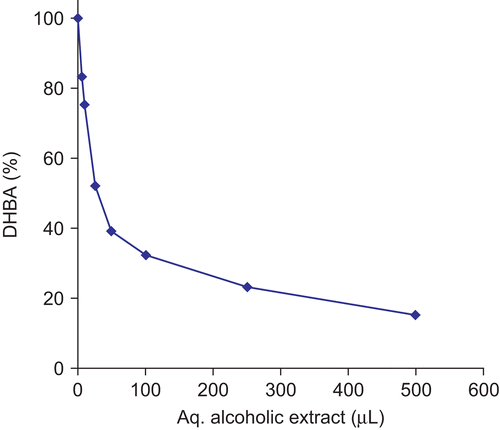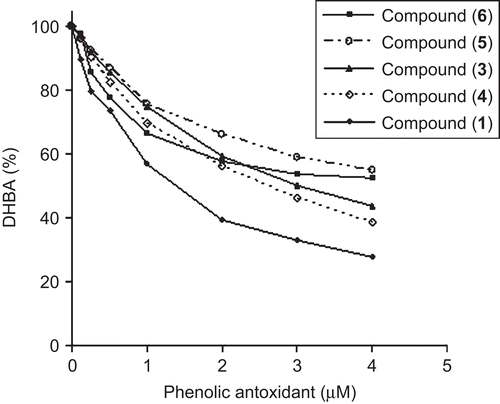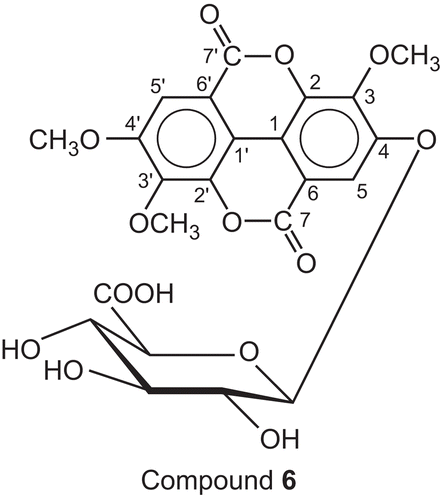Abstract
The new trimethoxy-ellagic glycoside, 3,3′,4′-tri-O-methylellagic acid 4-O-β-glucupyranuronide and twelve known phenolics were isolated from the leaves of Conocarpus erectus L. (Combretaceae). Structures of all compounds were determined on the basis of spectroscopic methods and chemical degradation. The new compound, together with four of the isolated known constituents and the plant extract itself, showed potent inhibitory effect against reactive oxygen species attack on salicylic acid in a dose-dependent manner adopting xanthine/hypoxanthine oxidase assay.
Introduction
Conocarpus erectus L. (Combretaceae), known in English as buttonwood or button mangrove, is one of two species in the genus Conocarpus. The plant is an evergreen tree 6 m tall with spreading crown, grey or brown bark, glaucous medium-green leaves and greenish flowers in dense cone-like heads in terminal panicles (CitationBailey, 1976). It is a folk remedy for anemia, catarrh, conjunctivitis, diabetes, diarrhea, and fever (CitationIrvin, 1961). The buttonwood tree, Conocarpus erectus, has not been investigated previously for its biological activity or for its constitutive phenolics. Due to the interest in the biological activity as well as the diverse plant bioactive metabolites (CitationAyoub, 2003; CitationHussein et al., 2003; CitationAyoub et al., 2004) an investigation of the phenolics of the leaves of C. erectus was undertaken. Thirteen phenolics (1-13), including the new natural product 3,3′,4′-tri-O-methylellagic acid 4-O-β-glucupyranuronide (6) have been isolated and purified from the aqueous alcohol extract of the leaves of this plant. All structures were confirmed by FTESI-MS and NMR analysis. In addition, the antioxidant potential based upon the principle of xanthine/hypoxanthine oxidase assay of the plant leaf extract, the new , together with the glucuronides, quercetin 3-O-glucupyranuronide (3), myricetin 3-O-β-glucupyranuronide (4), 3′,5′-dimethoxymyricetin 3-O-β-glucupyranuronide, syringetin 3-O-β-glucupyranuronide (5) and gallic acid (1) was also performed.
Materials and methods
Instruments and materials
1H NMR spectra were measured with a Jeol ECA 500 MHz NMR spectrometer, at 500 MHz. 1H chemical shifts (d) were measured in parts per million (ppm), relative to TMS and 13C NMR chemical shifts to DMSO-d6 and converted to TMS scale by adding 39.5. Typical conditions: spectral width = 8 kHz for 1H and 30 kHz for 13C, 64 K data points and a flip angle of 45°. FTMS spectra were measured on a Finnigan LTQ-FTMS (Thermo Electron, Bremen, Germany) (Department of Chemistry, Humboldt-University, Berlin). UV recording were made on a Shimadzu UV-Visible-1601 spectrophotometer; [α]D was measured on a KRüSS Optronic automatic polarimeter P8000. Analytical HPLC was conducted on a Hewlett-Packard (HP) 1090 liquid chromatograph fitted with a C-18, reverse-phase (5 mm) column (25 cm, 4 mm I.D.; Latex, Eppelheim, Germany). UV detector was set at 325 nm for the detection of the products (2,5-dihydroxybenzoic acid and 2,3-dihydroxybenzoic acid) produced by reactive oxygen species (ROS) attack on salicylic acid. The mobile phase consisted of 0.005 M tetrabutylammonium hydroxide in distilled water, pH 4.3 (with formic acid). The flow rate of the mobile phase was 1 mL/min. Instrument control and data handling were performed with the HP Chemstation software on a PC. Hypoxanthine, xanthine, xanthine oxidase and EDTA were obtained from Merck (Darmstadt, Germany); NH4SO4 and phosphate buffer obtained from Serva (Heidelberg, Germany); salicylic acid and FeCl3.6H2O were obtained from Aldrich Chemie (Steinheim, Germany). Paper chromatographic analysis was carried out on Whatman No. 1 paper, using solvent systems: (1) H2O; (2) 6% HOAc; (3) BAW (n-BuOH-HOAc-H2O, 4:1:5, upper layer). Solvent 3 was used for PPC (preparative paper chromatography).
Plant material
Fresh leaves of Conocarpus erectus were collected from a mature tree growing in Orman garden, Cairo, Egypt, during May 2006. Voucher specimen R-3426-06 (The plant was identified by Prof. Dr. Abdel Salam El-Nowaihi, Professor of taxonomy, Faculty of Science, Ain-Shams University, Egypt) was deposited at the herbarium of the Department of Pharmacognosy, Faculty of Pharmacy, Ain-Shams University, Cairo, Egypt.
Extraction and isolation
The fresh leaves Conocarpus erectus (3 kg) were homogenized in EtOH-H2O (3:1) mixture (three extractions each with 5 L). The dried filtrate (230 g) of the homogenate was applied on a polyamide 6s (1500 g) (Riedel-De-Hän Ag, Seelze Hannover, Germany) column (150 × 7.5 cm) and eluted with H2O followed by H2O-MeOH mixtures of decreasing polarities to yield five fractions (I-V), which were individually subjected to 2D-PC. Compounds 1 (175 mg) and 2 (75 mg) were isolated pure from fraction I (eluted with 20%) by column fractionation (CF) of 2.19 g material over 35 g Sephadex LH-20 using 2 L of H2O for elution. Compounds 3 (188 mg), 4 (102 mg), and 5 (154 mg) were individually separated from 1.2 g of fraction II (eluted with 40%) by repeated prep. PC, using BAW as solvent, while compounds 6 (75 mg) and 7 (123 mg) were obtained from 780 mg of fraction III (eluted with 60%) by CF on Sephadex LH-20, using 4 L of a mixture of H2O/MeOH (1: 2) for elution. Compounds 8 (78 mg), 9 (63 mg), 10 (111 mg) were obtained from 908 mg of fraction IV (eluted with 80%) by fractionation on a polyamide 6s (13 g) column and elution with EtOAc saturated with water. Compounds (11-13) were individually isolated pure through repeated CF of 2.65 g of fraction V (eluted with MeOH) on a polyamide 6s (20 g) column and elution with a mixture of MeOH-C6H6-H2O (60:38:2).
New natural product
3,3′,4′-tri-O-Methylellagic acid 4-O-β-glucupyranuronide (3,3′,4′-trimethoxyellagic acid 4-O-β-glucupyranuronide) (6)
White amorphous powder, Rf-values: 0.27 (H2O), 0.38 (HOAc), 0.55 (BAW), [α]D 12:08o (c = 0.042, MeOH). UV max nm in MeOH: 252, 265shoulder, 302shoulder, 366. HRESIMS: m/z = 520.1615 [M-H]−, (C23H20O14). Acid hydrolysis gave glucuronic acid and 3,3′,4′-trimethoxyellagic acid (6a). 3,3′,4′-trimethoxyellagic acid (6a): Rf-values: 0.13 (H2O), 0.18 (HOAc), 0.75 (BAW). UV max (nm) in MeOH: 246, 348shoulder, 372 nm; in MeOH. EIMS: [M]+at m/z = 344. NMR data: δ (ppm): 1H: 7.61 (s, H-5′), 7.5 (s, H-5), 4.06 and 4.07 (each as a singlet, CH3-3 and CH3-3′), 3.84 (s, CH3-4′). 13C: 111.2 (C-1), 140.7 (C-2), 140.4 (C-3), 152.9 (C-4), 112.1 (C-5), 112.4(C-6), 158.8 (C-7), 112.4 (C-1′), 141.4 (C-2′), 140.5 (C-3′), 153.8 (C-4′) 107.8(C-5′), 114.4 (C-6′), 158.9 (C-7′), 61.5 (C-3′), 61.2 (C-3), 57.7 (C-4′). Parent compound (6): NMR data: δ (ppm): 1H: aglycone moiety: 7.78 (s, H-5), 7.61 (S, H-5′), 4.17 and 4.14 (each as a singlet, CH3-3 and CH3-3′), 3.78 (s, CH3-4′); glucuronide moiety: 5.2 (d, J = 8 Hz, H-1”), 3.2-3.9 (m, glucuronic acid protons overlapped with OH protons). 13C: aglycone moiety: 114.2 (C-1), 140.7 (C-2), 141.4 (C-3), 151.0 (C-4), 112.1 (C-5), 112.0 (C-6), 158.8 (C-7), 112.4 (C-1′), 140.6 (C-2′), 140.4 (C-3′), 153.6 (C-4′), 107.8(C-5′), 112.4 (C-6′), 158.9 (C-7′), 61.4 (C-3′), 61.2 (C-3), 57.7 (C-4′); glucuronide moiety: 101.5 (C-1”), 71.6 (C-2”), 74.1 (C-3”), 76.4 (C-4”), 76.5 (C-5”), 170.5 (C-6”).
Hypoxanthine/xanthine oxidase assay
The assay used to determine the antioxidant potential of the aqueous alcoholic leaf extract of Conocarpus erectus and the individual purified phenolic compounds was based on the methods of (CitationOwen et al., 1996). Major phenolics (1, 3-6) were dissolved, individually, in the assay buffer (1 mL) and tested in the concentration range of 0-4 mM. A 10 μL aliquot of xanthine oxidase (18 M) in 3.2 M NH4SO4 was added to initiate the reactions. The sample tubes were incubated for 3 h at 37°C, at which time the reaction was complete. The reaction mixture (1μL) was analyzed by HPLC using the mobile phase and conditions described for analytical HPLC. Samples for determination of the antioxidant capacity of the extract (2 g) were prepared by placing 500 μL of methanol solutions of the extract in 15 mL centrifuge tubes (in duplicate) and removing the solvent under a stream of nitrogen. Brine samples were prepared by adding 500 μL to 15 mL centrifuge tubes followed by lyophilization. The dried sample material was suspended in the assay buffer (1 mL) prior to addition of xanthine oxidase. The concentration of the hydroxylation of salicylic acid product was monitored at 325 nm. Quantitation of the phenolic components of Conocarpus extract dissolved in the assay’s phosphate buffer and end-products of the enzyme or free-radical reactions was performed using appropriate standard curves of absorption versus concentration measured for the pure compounds.
Results and discussion
The received extract was inspected for its constitutive phytochemicals (CitationHarborne, 1973) to prove the presence of a high percent of phenolics (intense blue FeCl3 color reaction and chromatographic analysis). The extract was initially fractionated by a polyamide 6s column using water/methanol mixtures of decreasing polarities for elution.
Compound (6) is an amorphous yellow powder that exhibits chromatographic characteristics and UV spectral maxima in MeOH closely similar to those reported for methoxy-ellagic acid-O-glycosides (CitationHussein et al., 2007). Acid hydrolysis of (6) (2 N aqueous HCl, 3 h, 100°C) yielded glucuronic acid (comparative paper chromatography, CoPC) and an aglycone (6a), which was precipitated from the cold aqueous hydrolysate, filtered off and washed with water. The aglycone (6a) was also released after incubating the parent compound (6) with β-glucuronidase enzyme (lyophilized chromatographically pure, salts free enzyme BDH) for 24 h, at 37°C. It exhibited UV maxima which were reminiscent of acids and showed an [M]+ molecular ion at m/z = 344 in its EI-MS spectrum. The 1H NMR spectrum of 6a exhibited beside the two aromatic signals at δ ppm 7.78 (s, H-5), 7.61 (S, H-5′), three methoxyl signals at δ ppm 4.17, 4.14 (each as a singlet, CH3-3 and CH3-3′) and 3.78 (s, CH3-4′) consistence with a 3,3′,4′-trimethoxyellagic acid as was further confirmed through 13C NMR analysis (CitationKhac et al., 1989). The parent compound, (6) had the molecular formula C23H20O14 as indicated by HRFTESIMS [M-H]−: 520.3415. Consequently compound (6) was suggested to be 3,3′,4′-trimethoxyellagic acid-O-β-glucuronide. In order to determine unambiguously the structure of (6) NMR analysis was therefore applied. The 1H spectrum (DMSO-d6, room temperature) revealed the characteristic pattern of proton resonances of the aglycone (6a). However, a distinction can be made, whereby the resonance of the H-5 proton (see formula) in the spectrum of the aglycone, which appeared as a singlet at δ ppm 7.5 was found to be downfield, shifted to δ ppm 7.78 in the spectrum of compound (6). This downfield shift, together with the presence of the resonance of the H-5′ proton in both spectra (of 6 and 6a) unchanged (singlet at 7.61 ppm in both cases) is obviously due to glycosylation of the vicinal OH group at position 4 in the molecule of 6 by the glucuronide moiety. The presence of the glucuronide moiety itself followed from the anomeric hexose proton resonance at δ ppm 5.2 (d, J = 8 Hz) in the spectrum of 6, attributed to proton H-1 of the glucuronide moiety. In an HMBC spectrum this proton signal was found to be correlated across three bonds, 3J to the aglycone carbon C-4, thus adding further support to the proposed structure of compound (6) as 3,3′,4′-trimethoxyellagic acid 4-O-β-glucuronide. Finally, the 13C NMR analysis confirmed the structure of (6). As expected, the spectrum exhibited 6 distinct glucuronic acid carbon resonances (see Materials and methods) (CitationNawwar and Buddrus 1981). The β-anomer was recognized from the resonance at δ ppm 101.6, and the glucuronic carboxyl carbon from the downfield resonance at δ ppm 170.5. In this spectrum the recorded 13C chemical shifts of the resonances of the 3,3′,4′-trimethoxyellagic acid moiety confirmed substitution at the 4-position. This followed from the relative up-field shift (δδ = 1.9 ppm, see Materials and methods) of the resonance of C-4 in comparison with the corresponding resonance in the spectrum of the aglycone. Furthermore, the measured chemical shift values of the carbons of the glucuronide moiety confirmed that it existed in the pyranose form. Consequently, compound (6) is identified to be 3,3′,4′-trimethoxyellagic acid 4-O-β-glucupyranuronide, which has not been reported previously in nature.
Known compounds: Each of the known compounds (1-5 and 7-13) has been individually separated pure by repeated column and/or preparative paper chromatography. Their identities (given in ) were achieved mainly by chromatographic, UV, FTESIMS, 1H and 13C NMR analysis.
Table 1. Isolated known phenolic compounds from Conocarpus erectus.
Compound (6) was isolated and identified as a new trimethoxy-ellagic glycoside. The antioxidant capacity of the extract was determined by monitoring the production of hydroxylated benzoic acids (DHBA) due to attack of ROS on salicylic acid in the hypoxanthine/xanthine oxidase assay (CitationOwen et al., 1996). The reduction of total oxidation products as a function of the volume of extract added to the assay is shown in . The extract had IC50 value of 40 μL for the hypoxanthine/xanthine oxidase assay. The higher efficiency in the hypoxanthine/xanthine oxidase assay for the extract is probably due to the observed significant inhibition of xanthine oxidase activity (IC50 = 250 μL). The extract also inhibited the attack of ROS in a dose-dependent manner.
Figure 1. Inhibitory effect of Conocarpus erectus on the production of dihydroxybenzoic acids (DHBA) from salicylic acid in the hypoxanthine/xanthine oxidase assay.

The major phenolics isolated from C. erectus, gallic acid (1), quercetin 3-O- glucupyranuronide (3), myricetin 3-O-β-glucupyranuronide (4), 3′,5′-dimethoxymyricetin 3-O-β-glucupyranuronide, syringetin 3-O-β-glucupyranuronide (5) and the new compound 3,3′,4′-trimethoxyellagic acid 4-O-β-glucupyranuronide (6) were tested individually in the hypoxanthine/xanthine oxidase assay. Each compound inhibited the hydroxylation of salicylic acid by ROS in a dose-dependent manner as shown in with the IC50 value listed in the figure legend. The most effective was gallic acid (1) (1.43 mM) and 3,3′,4′-trimethoxyellagic acid 4-O-β-glucupyrauronide (6) (11.22 mM) the least effective compound. The antioxidant potential of the flavonol glucuronides (3-5) in terms of their ability to scavenge ROS could be tested by this method, in addition, to their direct inhibitory effect on xanthine oxidase (CitationHalliwell & Gutteridge 1993). The present study represents the first report of potential antioxidant of Conocarpus erectus extract as well as its purified phenolics based on hypoxanthine/xanthine oxidase assay.
Figure 2. Inhibitory effect of purified phenolic compounds on the production of dihydroxybenzoic acids (DHBA) from salicylic acid in the hypoxanthine/xanthine oxidase assay. Compounds and IC50 values are: gallic acid (1) (1.43 μM), myricetin 3-O-β-glucupyranuronide (4) (2.60 μM), quercetin 3-O-glucupyranuronide (3) (3.14 μM), syringetin 3-O-β-glucupyranuronide (5) (7.01 μM), and 3,3′,4′-trimethoxyellagic acid 4-O-β-glucupyranuronide (6) (11.22 μM).

Acknowledgements
The author is grateful to Professor Dr. R.W. Owen, Division of Toxicology and Cancer Risk Factor, German Cancer Research Center (DKFZ), Heidelberg, Germany, for hosting the antioxidant activity at his lab.
Declaration of interest
The Author declares that there is no conflicts of interest to disclose. The author would like to express her utmost gratitude to the Egyptian government for its generous post doctor and scientific mission.
References
- Alam A, Tsuboi S (2007): Total synthesis of 3,3′-4-trimethoxy ellagic acid from gallic acid. Tetrahedron 63: 10454–10465.
- Ayoub N (2003): Unique phenolic carboxylic acids from Sanguisorba minor. Phytochemistry 63: 433–436.
- Ayoub N, Hussein S, Reiss C, Mentel R and Lindequist U. (2004): Antiviral and antibacterial phenolics from Rubus sanctus Schreb. Bull Fac Pharm Cairo Univ 42: 223–231.
- Bailey LH (1976): Hortus Third: A Concise Dictionary of Plants Cultivated in the United States and Canada. New York, MacMillan Collier MacMillan, p.306.
- Bohm BA, Collins FW (1975): Flavonoids of Philydrum lanuginosumbruce. Phytochemistry 14: 315–316.
- Harborne JB (1973): Phytochemical Methods. London and New York, Chapman & Hall, pp. 39-236.
- Halliwell B, Gutteridge JMC (1993): Free Radicals in Biology and Medicine. Oxford, Clarendon Press, pp.36-104.
- Hussein S, Ayoub N, Nawwar M (2003): Caffeoyl sugar esters and an ellagitannin from Rubus sanctus. Phytochemistry 63: 905–911.
- Hussein S, Hashim A, El-Sharawy R, Seliem M, Lindequist U, Nawwar M (2007): Ericifolin: An eugenol 5-O-galloylglucoside and other phenolics from Melaleuca ericifolia. Phytochemistry 68: 1464–1470.
- Irvin FR (1961): Woody Plants of Ghana. London, Oxford University Press, p. 868.
- Khac DD, Tran-Van S, Campos AM, Lellemand J-Y, Fetizon M (1989): Ellagic compounds from Diplopanax stachyanthus. Phytochemistry 28: 251–257.
- Nakanishi T, Inatomi Y, Murata H, Ishida S, Fujino Y, Miura K, Yasuno Y, Akira Inada A, Lang FA, Murata J (2007): Triterpenes and flavonol glucuronides from Oenothera cheiranthifolia. Chem Pharm Bull 55: 2334–2338.
- Nawwar M, Buddrus J (1981): A gossypetin glucuronide sulphate from the leaves of Malva sylvestris. Phytochemistry 20: 2446–2448.
- Nawwar M, Buddrus J, Bauer H (1982): Dimeric phenolic constituents from the roots of Tamarix nilotica. Phytochemistry 21: 1755–1758.
- Nawwar M, SoulemanA Buddrus, J, Bauer H, Linscheid M (1984): Polyphenolic constituents of the flowers of Tamarix nilotica: The structure of nilocitin, a new digalloylglucose. Tetrahedron Letters 25: 49–54.
- Nawwar M, Hussein S, Merfort I (1994): NMR spectral analysis of polyphenols from Punica granatum. Phytochemistry 36: 793–798.
- Nonaka G, Nishimiora H, Nishioka I (1985): Tannins and related compounds. Isolation and structure of stenophllanins A, B, and C, novel tannins from Quercus stenophylla. J Chem Soc Perkin Trans I: 163–172.
- Owen R, Wimonwatwatee T, Spiegelhalder B, Bartsch H (1996): A high performance liquid chromatography method for quantification of hydroxyl radical formation by determination of dihydroxy benzoic acids. Eur J Cancer Prevention 5: 233–240.
- Yasukawa K, Ogawa H, Takido M (1990): Two flavonol glycosides from Lysimachia nummularia. Phytochemistry 29: 1707–1708.
